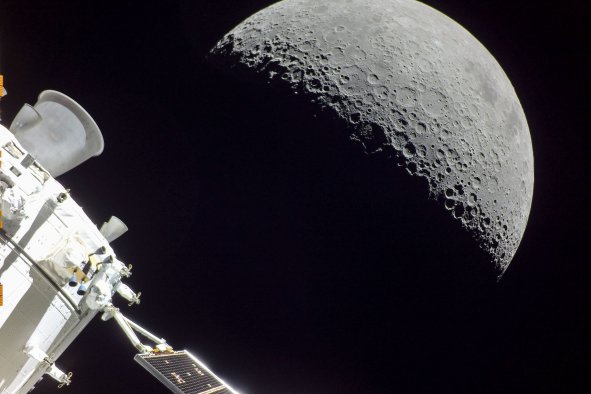Paleontologists working in Patagonia have unearthed the oldest-known fossil of a tadpole—and it was a whopper, measuring in at more than six inches long, the size of an adult human hand.
The specimen, which lived some 161–168 million years in the Jurassic Period, is thought to have failed to complete its metamorphosis into a frog, before being buried in ash and silt.
The discovery is helping to clear up a long-standing mystery as to when frogs and toads evolved their iconic two-stage life-cycle.
"The research demonstrates that a tadpole stage followed by a drastic metamorphosis was a successful strategy of great relevance to the evolution of frogs and toads," paper author and herpetologist Mariana Chuliver of Universidad Maimónides, Argentina, told Newsweek.
Both frogs and toads belong to a group of tailless amphibians known to science as the "anurans."
Modern anurans are notable for having a two-stage lifecycle. Eggs lain in water hatch into (usually water-dwelling) larvae known as tadpoles.
Tadpoles are legless and typically have a few fish-like features not seen in adult frogs; for example, they have tails, gills for breathing, and an underwater sensory apparatus based on detecting vibrations.
After weeks or months, these larvae undergo a process of metamorphosis, which see the tadpoles change into frogs—growing legs, lungs to breathe on land, changing mouthparts to eat meat rather than plants, and shrinking and absorbing their tail.
Exactly when this fantastic transformation first evolved, however, has been something of a long-standing puzzle.
Frogs can be found in the fossil record as early as the Late Triassic (around 217–213 million years ago)—but tadpoles had previously only been known to go back to the Cretaceous Period, specifically around 145 million years ago.
Scientists have previously suggested that the key features of tadpoles likely evolved around the boundary between the Triassic and Jurassic Periods (that is, 201.4 million years ago).
However, as Chuliver and colleagues explain in their paper, "these hypotheses are based solely on evidence from extant [living] anurans and remain untested because fossil tadpoles are completely absent in the Triassic and Jurassic fossil record.
"Thus, the timing and evolutionary transformations involved in the origins of the tadpole body plan remain enigmatic and a matter of debate."
In their study, the team describe the discovery of a fossil tadpole of the Mid-Jurassic frog species Notobatrachus degiustoi in Argentina's Santa Cruz province.
The fossil came from a layer in the rocks known as the "La Matilde Formation," from which adult N. degiustoi, which are notable for their giant size, have previously been unearthed.
"As with most extant species, not all tadpoles succeed in metamorphosing, so many of them die when the ponds dried out," Chuliver said.
"Our tadpole probably died naturally, and after its death was covered by volcanic ash and silt, which is a fine grain sediment.
"The deposition of these sediments promoted an exquisite preservation of the specimen, which lasted more than 160 million years."
The fossil specimen—also large, at six inches from head to tail—sports most of the tadpole's body and part of its tail.
Visible are the larvae's eyes, nerves, and a forelimb; the latter suggests that the tadpole was in the late stages of its metamorphosis into an adult when it died and was preserved.
"Its exquisite preservation, including soft tissues, shows features associated with the filter-feeding mechanism characteristic of extant tadpoles," the team wrote.
According to the researchers, gigantism appears several times in the evolutionary history of anurans, but this is one of the few species known to have both giant frogs and tadpoles.
The researchers believe that N. degiustoi likely reached its giant size—which rivaled that of most anurans alive during the age of reptiles (251.9–66.0 million years ago)—as a result of having a long development time in seasonal ponds.
"The high availability of food resources, the absence of predators, and the absence of competitors such as fish or other anuran species were key factors for the tadpoles to grow giant," Chuliver explained.
Regardless, the researchers conclude, the discovery of this oldest-known tadpole reveals that anurans developed their two-stage life cycle early in their evolutionary history—with this pattern having "remained stable for at least 161 million years."
Do you have a tip on a science story that Newsweek should be covering? Do you have a question about fossils? Let us know via science@newsweek.com.
Reference
Chuliver, M., Agnolín, F. L., Scanferla, A., Aranciaga-Rolando, M., Ezcurra, M. D., Novas, F. E., & Xu, X. (2024). The oldest tadpole reveals evolutionary stability of the anuran life cycle. Nature. https://doi.org/10.1038/s41586-024-08055-y
Disclaimer: The copyright of this article belongs to the original author. Reposting this article is solely for the purpose of information dissemination and does not constitute any investment advice. If there is any infringement, please contact us immediately. We will make corrections or deletions as necessary. Thank you.



